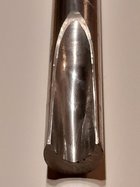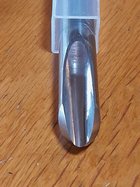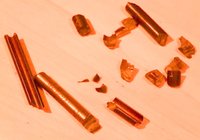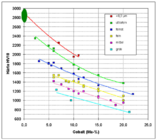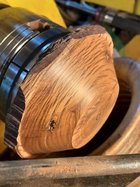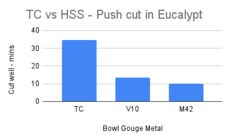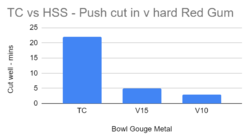so why hasn’t anyone developed a bowl gouge made with/of carbide that stays sharp like carbide scrapers? Seems doable.
-
November 2025 Turning Challenge: Wall Hanging! (click here for details) -
Sign up for the 2025 AAW Forum Holiday Swap by Monday, November 24th (click here for details) -
Congratulations to Konstantin Gusev for "The Nutcracker" being selected as Turning of the Week for November 17, 2025 (click here for details) -
Welcome new registering member. Your username must be your real First and Last name (for example: John Doe). "Screen names" and "handles" are not allowed and your registration will be deleted if you don't use your real name. Also, do not use all caps nor all lower case.
You are using an out of date browser. It may not display this or other websites correctly.
You should upgrade or use an alternative browser.
You should upgrade or use an alternative browser.
Carbide gouges
- Thread starter Alan Weinberg
- Start date
I don't think that would work so well. It would be very brittle and difficult to sharpen. Also doesn't get as sharp as high speed steels
- Joined
- Jan 27, 2005
- Messages
- 13,174
- Likes
- 5,747
- Location
- Dalworthington Gardens, TX
- Website
- pbase.com
so why hasn’t anyone developed a bowl gouge made with/of carbide that stays sharp like carbide scrapers? Seems doable.
The Hunter's tools essentially do what you are looking for. If you are asking about a carbide tool that looks like a bowl gouge, there are many reasons why not. A few that immediately come to mind are:
- There are probably nearly as many "favorite" edge profiles as there are professional woodturners
- A carbide profile can't be changed
- Even just a carbide tip would be prohibitively expensive
- Carbide is extremely brittle so an entire carbide bowl gouge would be hazardous
- Without specialized equipment, carbide couldn't be sharpened
- What's the problem with sharpening HSS bowl gouges? It's quick and easy.
- HSS turning tools have microscopic carbide particles embedded in the steel so you get much of the wear resistance of carbide without the prohibitive expense.
- If you've ever dropped a solid carbide router bit, you know not to look down ... it will only make you cry.
As Bill mentioned Hunter carbide tools will fill the bill. I use them in conjunction with my Thompson tools. Way back when I started my turning journey I made a tool consisting of a tube tapped for a grub screw where a 2 flute carbide double ended ball mill was attached. It made a carbide finishing tool, it worked to some extent but just not as sharp as would be hoped. Ended up on the heap of almost good tools.
didn’t know that.HSS turning tools have microscopic carbide particles embedded in the steel so you get much of the wear resistance of carbide without the prohibitive expense.
The reasoning offered is appreciated. Sharpening is (now) no big deal but my mind was just meandering. Seems like gouges have progressed re holding an edge—HSS steel, for example—and I wondered if carbide would be a next step.
Well, you would need diamond wheels for sharpening them. You can to some touch ups on CBN wheels, but they don't like to cut carbide and will wear your wheel out a lot faster. No clue as to how costly they would be. Can't remember, but some one did make some carbide and tantung gouge tips and tested edge holding. It might have been in tips and techniques. There were some tools that were made from V15, but they weren't around for very long. The metal was just too brittle.
robo hippy
robo hippy
Carbide inserts don't last forever, neither would a carbide traditional gouge. I thought the sales pitch on carbide inserts was limited sharpening. But go to a pen turning site and you'll find all kinds of methods on how to sharpen them. Penn State marketed traditional tools with carbide tips. Not sure if they still do or not.
Oh its highly doable alright, I have a 3/8 TCT bowl gouge tip much like the Woodcut tools glued on with Loctite . It performance is bar none on Australian hardwoods, the only done side i/you/we will need a another type of grinding wheel to sharpen it. I got mine for doing a review on it and if I had the chance I would have 3 or 4 of them as edge retention with our hardwoods is a major issue. I have a fair amount of Inland Rosewood or Boonaree https://www.wood-database.com/boonaree/ This wood laughs at every gouge I have including a 1/2 Thompson bowl Gouge. What tends to be a killer down here is other chemicals in the trees with silica being one in particular.
 www.abs.gov.au
and this chemical variance can be quite striking. I have a good amount of Blackwood or Acacia Melanoxylon and this is normally good to turn perhaps a little stiff and the curlies are nice and crisp. However.....
www.abs.gov.au
and this chemical variance can be quite striking. I have a good amount of Blackwood or Acacia Melanoxylon and this is normally good to turn perhaps a little stiff and the curlies are nice and crisp. However.....
 www.wood-database.com
The second tree I harvested has a lot of silica or something in it, as it will literally polish the edge off in 2 or 3 cuts on my 1/2" Thompson anything else is far worse, with the exception of the TCT gouge.
www.wood-database.com
The second tree I harvested has a lot of silica or something in it, as it will literally polish the edge off in 2 or 3 cuts on my 1/2" Thompson anything else is far worse, with the exception of the TCT gouge.
As to edge issues that can be successfully addressed during sharpening/grinding, see posts relating to DIY gouge tips etc
https://www.aawforum.org/community/threads/diy-bowl-gouges-and-flutes.20907/
and
 www.aawforum.org
www.aawforum.org
1301.0 - Year Book Australia, 1917
Australian Blackwood | The Wood Database (Hardwood)
As to edge issues that can be successfully addressed during sharpening/grinding, see posts relating to DIY gouge tips etc
https://www.aawforum.org/community/threads/diy-bowl-gouges-and-flutes.20907/
and
Bowl Gouge Flute Descriptors
Adding a few photos of gouges not covered thus far. First is a Carter & sons 5/8 deep fluted bowl gouge. A U-shaped flute. I find the transition from the round bottom to the straight cut upper difficult to have a grind without a bump. Certainly takes care. Second is a Oneway master cut 5/8 bowl...
I suspect the thinking behind Woodcut gouge tips. Is that you cant harden HSS to its maximum for the best edge retention, as due to the length would make it susceptible to breaking. The short gouge tip allows for maximum hardness an much better edge retension.didn’t know that.
The reasoning offered is appreciated. Sharpening is (now) no big deal but my mind was just meandering. Seems like gouges have progressed re holding an edge—HSS steel, for example—and I wondered if carbide would be a next step.
There is a narrow range where it could be feasible. But certainly cost is a major issue and also the method of sharpening you would need a totally different grinding set up. Many of the other issues can/could be addressed quite well. Neil Strong and have been are looking into this and several other options.The Hunter's tools essentially do what you are looking for. If you are asking about a carbide tool that looks like a bowl gouge, there are many reasons why not. A few that immediately come to mind are:
Other than the multitude of drawbacks, it's a great idea ... seriously ... but just isn't a practical idea.
- There are probably nearly as many "favorite" edge profiles as there are professional woodturners
- A carbide profile can't be changed
- Even just a carbide tip would be prohibitively expensive
- Carbide is extremely brittle so an entire carbide bowl gouge would be hazardous
- Without specialized equipment, carbide couldn't be sharpened
- What's the problem with sharpening HSS bowl gouges? It's quick and easy.
- HSS turning tools have microscopic carbide particles embedded in the steel so you get much of the wear resistance of carbide without the prohibitive expense.
- If you've ever dropped a solid carbide router bit, you know not to look down ... it will only make you cry.
Its hard woods like this that drive the search

Top 10 Hardest Woods in The World | Hitchcock & King
Hitchcock and King take you all over the world in order to tell you which wood is the hardest we know of, according to the Janka Rating System.
- Joined
- Jan 27, 2005
- Messages
- 13,174
- Likes
- 5,747
- Location
- Dalworthington Gardens, TX
- Website
- pbase.com
I haven't tried it yet, but TORMEK says that my diamond wheels can be used to sharpen carbide.
Neil Strong has been looking into this and several other options.
We (Hughie & I) are still in the research and development phase on TC gouge tips.
As Hughie points out, the greatest need for a TC gouge tip is for use on ultra hard woods of which we have a few down our way.
Why not just use some of the existing flat and cupped TC tips? I have some of those but don't like using them anywhere near as much as a traditional bowl gouge profile.
Here is a sneak preview...
As to some of the drawbacks that Bill Boheme raises...
- A carbide profile can't be changed
- Perhaps not quite as easily as doing so with HSS or with the same abrasives we use with those, but metal machinists do it all the time with their TC tools.
- Even just a carbide tip would be prohibitively expensive
- You may be right, but that is yet to be known from our project. And, it will also depend on the trade-offs. Certainly time at the grinder away from the lathe comes into the equation when turning very hard woods or an abrasive filled root ball.
- Carbide is extremely brittle so an entire carbide bowl gouge would be hazardous
- Yes, and thus just the ends in TC
- Without specialized equipment, carbide couldn't be sharpened
- For occasional re-sharpening CBN will do it, although it will be slightly slower (only 64% as efficient as diamond) and thus wear more to get the job done. If more regular re-sharpening is required diamond is a better option. There are various options there.
- HSS turning tools have microscopic carbide particles embedded in the steel so you get much of the wear resistance of carbide without the prohibitive expense.
- As with the benefits of HSS over carbon steel, HSS has benefits that you might be prepared to pay more for. The same might apply to TC for some woodturners.
- If you've ever dropped a solid carbide router bit, you know not to look down ... it will only make you cry.
- That issue is not restricted to TC. Here is what can happen to V10 from an impact... it can shatter like glass...
It's early days on this project and too soon to say anything on cost, but will report back here on the forum when we have something definite to say.
Last edited:
john lucas
AAW Forum Expert
I think you would have to sharpen it more often than you think to have a really keen edge. My Hunter carbides to seem to hold a goid edge for a long time when used as a bevel running tool.
My first CBN wheel cost me a bit north of $285. That wheel has sharpened nothing but Thompson tools and looks as new as the day I bought it. The next 4 were cheaper and still look good but there is no way I would try to sharpen carbide tools on them. I grimace when having a hands on and someone wants to grind something other than HSS on one of the CBNs available to them. If I see that I tell them to use the white wheel. There is quite a difference in a $50 white wheel and a $160+ CBN wheel. I have been using Thompson 10V tools ever since he started making them and I have dropped many of them and never has one broke. When visiting Doug's shop I found a 3/4" V tool laying on a pile and asked Doug what was wrong with it as it looked very good to me. He said see that little notch in the edge half way up the flute, it will break there. Well the doubting Thomas that I am I took it home and guess what? The very first cut the tool broke in half right where Doug said it would. I have never doubted anything Doug has to say about his tools since.
john lucas
AAW Forum Expert
I ground a Hunter 1/2" carbide cutter in half on my Dway CBN wheel. I needed to do that so I could measure the cutting angle. I was simply curious. One was wanting th know more about Hunter cutters and the other was simply to know if it would hurt my wheel. Didn't seem to. This wheel does not look new but then I've been using it as my only wheel for close to 10 years. It is a 180 and I still use it daily.
I think you would have to sharpen it more often than you think to have a really keen edge.
Yes, John, it would be about as often as you feel the need to rotate an insert.
And, that will depend on a number of factors:
- It depends on the grade of tungsten carbide. Sub-micron carbides increase the hardness, while a higher % of cobalt makes it softer but tougher (less brittle). The vertical axis in the following graph are Vickers harness numbers. We woodturners have a preference for at least 2,000 HV(10)...
- It depends on the woods we are using. In my testing I have had TC cut up to 8x longer than the HSS exotics on very hard and abrasive woods, but the HSS exotics start to catch up as the wood species become softer. For example, there is little to no difference in something as soft as pine.
- Of course, it depends on the tolerance of the turner for what they consider to be still sharp enough to continue to turn with.
- It also depends on the purpose of the cut. If it is bulk wood removal then sub-micron TC will continue cutting in a fashion in most wood species for longer than the HSS exotics, but the finish off the tool will start to deteriorate. Although, when freshly sharpened, sub-micron grade TC is more than capable of producing a fine finish off the tool...
To my touch, TC never feels as sharp as the HSS exotics, like M42 and V10, but when it comes to turning the tougher stuff a sub-micron TC gouge is more than sharp enough to get the job done in less time with fewer returns to the grinder
Last edited:
- Joined
- Jan 27, 2005
- Messages
- 13,174
- Likes
- 5,747
- Location
- Dalworthington Gardens, TX
- Website
- pbase.com
I will report here at some stage on the forum more fully on my test results on the performance of TC compared to various HSS bowl gouges steels, but here is a preview of the results from a test run on a mid-range Eucalypt...
Correction on the nomenclature, "V10" should be "CPM 10V" only if you know the steel is from Crucible (Thompson tools). Otherwise, you should use the generic nomenclature "A11".
Correction on the nomenclature, "V10" should be "CPM 10V" only if you know the steel is from Crucible (Thompson tools). Otherwise, you should use the generic nomenclature "A11".
I use the generic term V10 for a HSS with 10% vanadium composition. I haven't identified it as "CPM 10V" and will not be identifying any steel manufacturer or tool maker (unless it is myself) in the write up of my test results... I have no wish to go there.
The only generic term for CPM 10V steel is either 10V or A11. I have never seen it referred to as V10.
The only generic term for CPM 10V steel is either 10V or A11. I have never seen it referred to as V10.
Yes, Bill, it is just being used by me here as a shorthand way to identify the percentage of vanadium in the steel I'm testing without identifying it as either a Crucible Specialty Metal's propriety CPM® 10V® or a non-Crucible A11 versions of the steel with the same percentage of vanadium.
I'm avoiding using both the 10V® and A11 terms because I don't want to identify the manufacturer. If I use 10V® it will identify the manufacturer as Crucible, but if I use A11 it will identify it as a non-Crucible manufacturer. I'm testing the performance of the metallurgy, not the products of any one particular manufacturer.
Likewise, I'm using V15 for the same reason. I will define that nomenclature when I do the writeup of my testing results.
Doug Thompson has made 15V tools, what we found was that 15V steel can be chippy (little chips at the cutting edge). I do on occasion use my 15V 5/8V gouge with the most difficult woods and I for the most part I'll agree that it does a little better than 10V in most of those cases. But I don't think it is worth the extra price and work involved in making them, let alone the price to buy them. As far as normal woods that most turners have available to them and use I find no advantage of 15V over 10V. Now again I stipulate this is me and my findings and by no means is this gospel.
john lucas
AAW Forum Expert
I have a 15v skew Doug made me when he first started. It holds an edge great and have never chipped the edge. He said the metal was simply too expensive and didn't think they would sell.
The Hunter's tools essentially do what you are looking for.
I too use a Hunter Hercules #3. I really like it and use it just as often as my bowl gouges now.As Bill mentioned Hunter carbide tools will fill the bill. I use them in conjunction with my Thompson tools.
The same shear/ cupped carbides Hunter uses on their tools can be purchased from AZ Carbide for $14. They call them a “Hogger.”
In addition to my Hunter version, which has a 5/8” square shaft, I’ve now made one of these cupped carbide chisels from scratch, for less than $20, using 1/2” square steel stock. It works just as well as the Hunter version.
just bought an Osprey but haven’t played with it yet.The Hunter's tools essentially do what you are looking for. If you are asking about a carbide tool that looks like a bowl gouge,
Thanks all. Interesting discussion.
I had one set of CBN wheels that were on the way out, as in they polished well, but didn't really 'sharpen'. I had some McNaughton blades that I had carbide tips put on, and they didn't cut well. I tried to sharpen them on that set of wheels. Shall we say that they polished even better after I tried the carbide tips on them. Never again, that is what the diamond wheels for the Tormek are for.
As for hard woods, that is an interesting list. I did a trade with some Mountain Mahogany, some years back with some guy in Australia who searched the outback for any woods that were denser than water. He made penny whistles out of them. He said there were some species of acacia that had density of 1.45. He sent me some blanks of them, and I didn't recognize any of the names. Most of the blanks were pen blank size.
robo hippy
As for hard woods, that is an interesting list. I did a trade with some Mountain Mahogany, some years back with some guy in Australia who searched the outback for any woods that were denser than water. He made penny whistles out of them. He said there were some species of acacia that had density of 1.45. He sent me some blanks of them, and I didn't recognize any of the names. Most of the blanks were pen blank size.
robo hippy
Doug Thompson has made 15V tools, what we found was that 15V steel can be chippy (little chips at the cutting edge). I do on occasion use my 15V 5/8V gouge with the most difficult woods and I for the most part I'll agree that it does a little better than 10V in most of those cases. ............ As far as normal woods that most turners have available to them and use I find no advantage of 15V over 10V.
I agree with you Bill about there being minimal difference in performance between 10% and 15% vanadium HSS until you get into the harder woods. The harder the woods the more measurable the difference, e.g...
On that very tough piece of Red Gum (Eucalytus camaldulensis) the 15% vanadium cut for almost twice as long as the 10% composition. Whether the additional cost of the 15% vanadium is worth it for a turner will depend on how much tough stuff you turn, at which point a Tungsten Carbide is worth considering given its much superior durability performance.
I know Cindy Drozda has said that CPM® 15V is chippy, but I have used it a lot over quite few years and haven't found it to be noticeably chippy myself. The difference there might be that Cindy uses a 40/40 grind, but I don't take the bevel below 55° with the 15% vanadium because of its larger vanadium carbides particles sizes, which might be more prone to chipping out from a 40° edge.
My subjective judgement (from everyday use in the workshop and not under controlled testing conditions) is that the 15% vanadium takes as keen an edge at 55°/> as the 10% and cuts as well for as long as the 10% and then continues on after that to cut in a fashion that is OK for tough wood removal. Both will need to have its edge refreshed for finishing cuts.
Although a submicron TC never feels as keen to the touch (to me) I have found that it does keep that edge that can give a satisfactory finishing cuts for much longer than either the 15% vanadium or the 10% composition on anything other than the softest of woods.
Last edited:
That's interesting. I was getting little chips like that on my Thompson 5/8 BG ground 40/40 (mostly taking bigger cuts roughing). I went to 45 edge and have not seen any more chips.(little chips at the cutting edge).
- Joined
- Jan 27, 2005
- Messages
- 13,174
- Likes
- 5,747
- Location
- Dalworthington Gardens, TX
- Website
- pbase.com
That's interesting. I was getting little chips like that on my Thompson 5/8 BG ground 40/40 (mostly taking bigger cuts roughing). I went to 45 edge and have not seen any more chips.
What do you use to sharpen your tools? (aluminum oxide, seeded gel, CBN, diamond, something else)
I use CBN, 600,slow speed with a platform.

